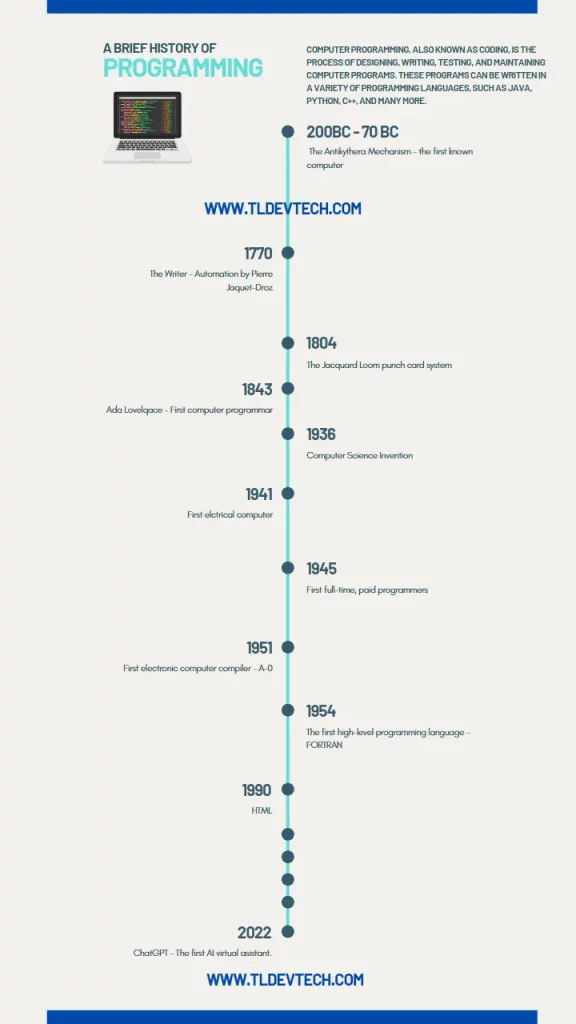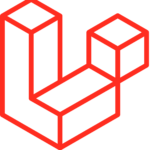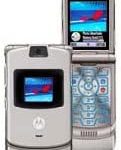Technology has changed the way we live our lives, and computer programming is at the heart of this transformation. From the earliest days of computers, programming has been an essential part of their development and use. In this article, we will explore the history of computer programming, from its earliest days to the present day. We will look at the major developments that have shaped the field, and the impact these advancements have had on our lives.

History of Computer Programming Timeline
Here is a brief timeline of some of the most significant events in the history of computer programming:
-
200BC – 70 BCThe Antikythera Mechanism – the first known computerClockwork devices were some of the earliest forms of “programming”. The Antikythera mechanism, which dates back to 200-70 BC, is the oldest known example of this.
It’s difficult to determine who was the first person to program a machine because of this. Before electronic computers, people used human and mechanical computers as well as clockwork devices.
These devices were often so complex that they could be “programmed” to do things like dance or write. -
1804The Jacquard Loom punch card systemThe Jacquard Loom, invented by Joseph Marie Jacquard, used a punch card system to control the weaving process. The punch cards were fed into the loom and controlled the weaving pattern, making it one of the earliest examples of computer programming.
The punched cards contained a pattern of holes that were read by a needle, which then raised or lowered the warp threads. When the shuttle traveled across the loom, it created a pattern in the fabric.
By changing the punched cards, different patterns and colors could be created with ease, in a fraction of the time it took before. -
1843First computer programmer – Ada LovelaceA British mathematician and writer, Ada Lovelace is often considered the first computer programmer.
She worked with Charles Babbage, an English mechanical engineer, to create the first computer program for his proposed Analytical Engine, which was never completed. -
1936Computer Science InventionAlan Turing, a British mathematician and computer scientist, proposed the idea of a universal machine that could perform any computational task that could be carried out by a human. This concept laid the foundation for modern computing and computer science.
-
1951First electronic computer compiler – A-0In 1951, Grace Hopper created A-0 (Arithmetic Language version 0), which was the initial electronic computer compiler for the UNIVAC I.
This compiler was a significant milestone in the history of computing, as it allowed programmers to write programs in a higher-level language, which could then be translated into machine code by the compiler. -
1954The first high-level programming language – FORTRAN (FORmula TRANslation)The language is developed by IBM, becoming the first high-level programming language. John Backus and his team at IBM developed the first compiler for FORTRAN, allowing programs to be written in a high-level language and translated into machine code.
FORTRAN was designed to make it easier for people to write complex programs for computers by translating formulas into a language the computer could understand. This breakthrough in programming language technology allowed for the development of more sophisticated computer programs. -
1958LISP (LISt Processor)LISP is developed by John McCarthy, becoming the first functional programming language. It allowed programmers to work with lists of data as well as manipulate them.
-
1964BASIC (Beginner’s All-purpose Symbolic Instruction Code)The programming language called BASIC, which stands for Beginner’s All-purpose Symbolic Instruction Code, was created by a team of developers consisting of John Kemeny, Mary Keller, and Thomas Kurtz. It was first made accessible to the public on May 1st, 1964.
-
1971PascalNiklaus Wirth created Pascal at ETH Zurich as a programming language that would be easy to teach. It quickly gained popularity as a useful tool for computer programming education. Pascal is still used today and is known for its simplicity and ease of use.
-
1971First computer virus – The CreeperThe Creeper, created by Bob Thomas, was the first computer virus. It spread through the ARPANET, a precursor to the internet, and displayed the message “I’m the creeper: catch me if you can!”
-
1972First anti-virus software – The ReaperRay Tomlinson created the first anti-virus software, known as The Reaper, to combat The Creeper. The Reaper was designed to detect and remove the Creeper virus from infected systems.
-
1975Altair 8800 and the birth of personal computingThe Altair 8800, created by Micro Instrumentation and Telemetry Systems (MITS), was the first personal computer. It was sold as a build-it-yourself kit and sparked a revolution in personal computing. Altair BASIC was the first commercial version of the BASIC programming language.
It was developed by Bill Gates, Paul Allen, and Monte Davidoff, and released on January 2, 1975. Altair BASIC was designed to be used on the Altair 8800. It allowed users to write programs and execute them on the computer, allowing them to do tasks such as word processing, accounting, and data processing. -
1983Apple Lisa and the first graphical user interfaceThe Apple Lisa, released in 1983, was the first personal computer to feature a graphical user interface (GUI). This allowed users to interact with the computer using a mouse and icons, making it easier to use than traditional command-line interfaces.
-
1985C++C++, created by Bjarne Stroustrup at Bell Labs, is an object-oriented extension of the C programming language. It was designed to provide a more powerful and flexible way for developers to create software applications.
C++ allows developers to create programs with greater control over memory management, data abstraction, and object-oriented programming techniques. With its ability to create efficient and reliable code, C++ has become one of the most widely used programming languages in the world. -
1990HTMLIn 1990, a revolutionary markup language was developed by Tim Berners-Lee, which would go on to change the face of the internet forever. This language, known as HTML (Hypertext Markup Language), was designed to enable the creation of web pages that could be easily accessed and navigated by users across the globe.
Since its inception, HTML has undergone numerous updates and revisions, with the most recent version being HTML5. -
1991The birth of LinuxIn 1991, Linus Torvalds developed an operating system called Linux that is free and open-source. Today, Linux is used extensively across various devices such as servers and smartphones.
Its popularity is due to its flexibility and the ability of users to customize it to their specific needs. Linux has a large community of developers who continuously improve and update the operating system. -
1991PythonGuido van Rossum createdPython, a high-level programming language designed to help developers write code that is easier to read and understand.
Python’s syntax is designed to be intuitive and straightforward, making it one of the most accessible programming languages for both experienced and novice developers alike.
By focusing on code readability, Python allows developers to create code that is more efficient and maintainable, allowing them to quickly deploy projects and reduce development costs. -
1995JavaA group of developers from Sun Microsystems created a programming language known as Java. One of the main figures behind its creation was James Gosling. The language was made available to the public that same year.
It is a programming language that can run on any platform without needing to be recompiled. This allowed developers to write code once and run it anywhere, making cross-platform development much easier. -
1995JavaScriptBrendan Eich, a programmer at Netscape, developed a scripting language that would quickly become a staple of web development. Named LiveScript, the language was soon renamed JavaScript and quickly gained popularity among developers worldwide.
With its ability to easily create interactive web pages and applications, JavaScript quickly became an invaluable tool for web developers. -
1998XMLXML is a coding language designed to help structure data in a way that makes it easier to read and understand. It was created by the World Wide Web Consortium (W3C) and officially recommended on February 10th, 1998.
This means that it has been widely accepted as a standard way of organizing information on the Internet. -
2014SwiftApple’s Swift programming language, released on June 2, 2014, is a powerful and intuitive tool for creating apps and programs for the Apple ecosystem.
With its simple and concise syntax, Swift makes coding for iOS, macOS, the Apple Watch, and AppleTV easier and more efficient than ever before. -
2012GoBy March 2012, version 1.0 of Go was released. In 2012, Google released Go, a popular programming language designed for concurrent and networked programming.
Go quickly gained traction among developers due to its easy-to-learn syntax and comprehensive standard library, which made it an excellent choice for quickly developing reliable and efficient applications. Go’s built-in concurrency and garbage collection features allowed developers to write powerful and efficient code.
Go has been used by many organizations and open-source projects in addition to being used in production at Google. -
2022ChatGPTChatGPT was introduced as a preliminary model on November 30, 2022. The AI-powered chatbot gained praise for its comprehensive replies and eloquent explanations on a wide range of subjects.
It provides programmers with a new resource for learning and problem-solving.
ChatGPT can be used as a virtual assistant to answer questions, provide explanations, and offer suggestions on programming-related topics. This can save programmers time and effort, allowing them to focus on more complex tasks.
The history of computer programming is an ongoing story that continues to unfold. From the early days of automation to the birth of mobile computing, programming has transformed the world in countless ways. As technology continues to evolve, we can only imagine what the future of programming will bring.





